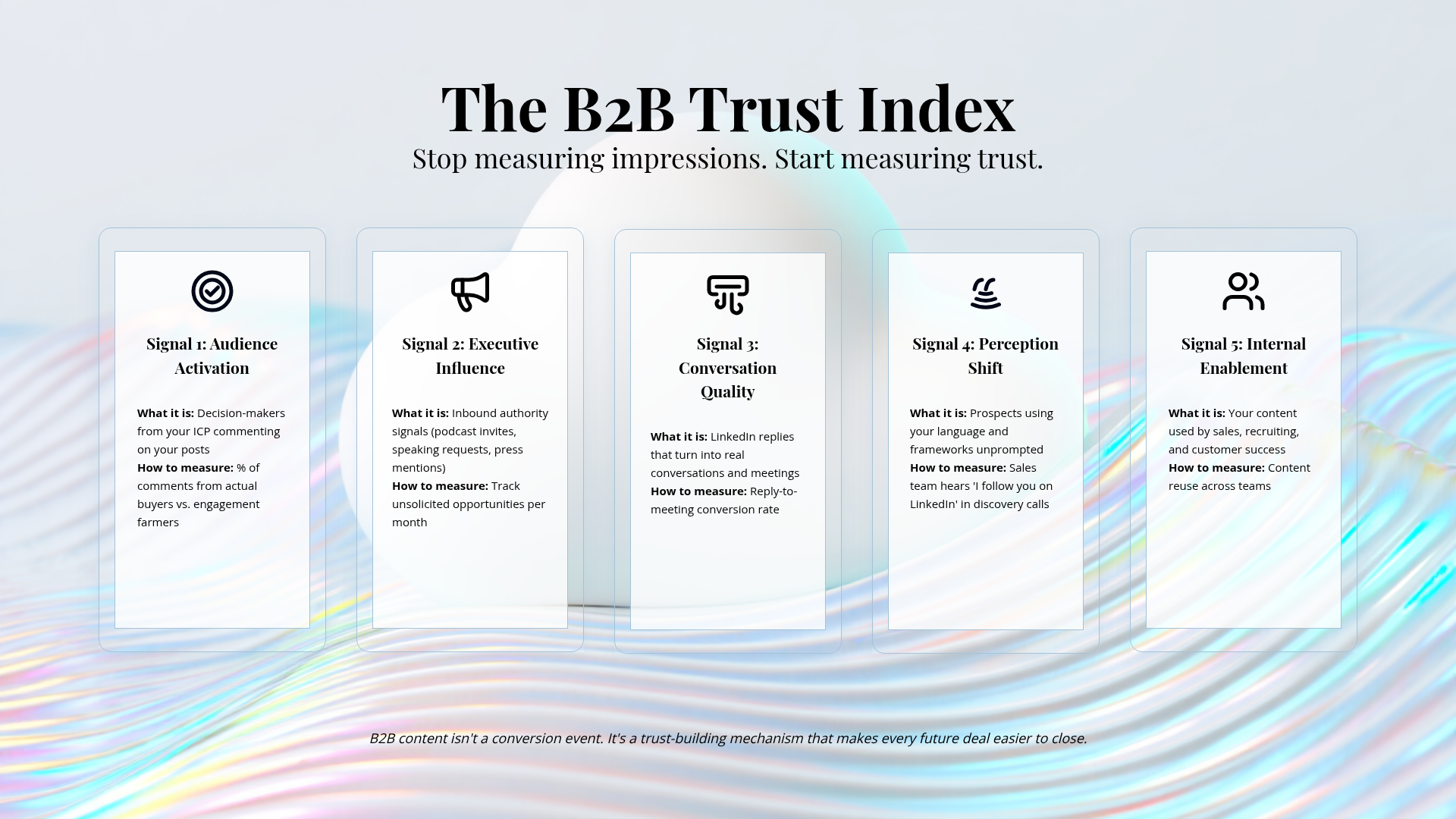Why Most B2B Content Strategies Fail (And What Actually Works)

Last week, I watched a founder delete their entire content calendar.
Six months of LinkedIn posts. Consistent 3x-per-week cadence. Good engagement numbers. Zero pipeline.
Their conclusion? "Content doesn't work for B2B."
But they were measuring the wrong thing.
The Performance Marketing Trap
Most B2B companies treat content like performance marketing. Post on Monday, book demos by Friday. When that doesn't happen, they panic and pivot to something else.
The problem isn't that content doesn't work. It's that they're applying consumer metrics to enterprise behavior.
Consumer apps optimize for immediate feedback loops. You post on Instagram, you get likes in minutes. The dopamine hit is instant. That's by design.
B2B buyers don't work that way. A $50K software purchase involves multiple stakeholders, extended evaluation periods, and real career risk. No single LinkedIn post closes that gap. No whitepaper converts a VP of Sales overnight.
What B2B Content Actually Does
Here's what nobody tells you: B2B content isn't a conversion event. It's a trust-building mechanism. And trust, by definition, cannot be manufactured quickly.
Think of it as building what I call a Trust Index—a composite of signals that accumulate over time. Not vanity metrics. Not impression counts. Real signals that indicate you're building authority that matters.
1. Audience Activation
The percentage of your posts that generate comments from actual decision-makers in your ICP, not just engagement farmers or other founders trying to boost their algorithm.
When a VP of Marketing at a Series B company comments on your post about pricing strategy, that's audience activation. When 47 random people drop fire emojis, that's not.
2. Executive Influence
The inbound that signals you've crossed a threshold. Podcast invites. Press mentions. Speaking requests. Partnership inquiries from companies you actually want to work with.
These don't happen because you went viral once. They happen because you've consistently demonstrated expertise over months. Because when someone thinks about your problem space, your name comes up.
3. Conversation Quality
What percentage of LinkedIn replies convert into substantive multi-message exchanges, and eventually, meeting requests?
This measures depth, not reach. Five meaningful conversations with qualified buyers beat 5,000 impressions from people who will never buy.
4. Perception Shift
This is the hardest to measure but the most valuable. It's when prospects start using your language. When they quote your frameworks in their own pitch decks. When your sales team hears "Yeah, I've been following them on LinkedIn" before they even explain what you do.
At Imagine AI, we see this with "high-fidelity personas" and "context engineering." When potential clients use these terms in discovery calls unprompted, we know the content is working.
5. Internal Enablement
When your sales team pulls your posts directly into their prospecting sequences. When recruiting uses your content to close candidates. When customer success references your posts in onboarding decks.
This is compound interest on content investment. You create it once, it works across your entire go-to-market motion.
The Time Horizon Problem
The fundamental issue is time horizon.
If you're optimizing for this quarter's pipeline, you'll write content that sounds like a pitch deck. Feature lists. Capability statements. Thinly veiled ads.
If you're optimizing for next year's competitive position, you'll write content that builds genuine authority. Provocative takes. Original frameworks. Transparent challenges.
The latter is harder to measure, which is why most companies don't do it. But difficulty of measurement and lack of value are not the same thing. In fact, they're often inversely correlated.
The most valuable strategic assets in business—brand, trust, culture—are notoriously difficult to quantify. That doesn't make them optional.
What This Looks Like In Practice
When we started Imagine AI two months ago, we didn't have a single customer or dollar of revenue. We had a hypothesis about AI-powered content and a lot of conviction.
We could have written generic "How AI is Transforming Marketing" posts. Safe. Broadly appealing. Completely forgettable.
Instead, we wrote about dropping out of grad school 31 days before Demo Day. About our motorcycle breaking down and what it taught us about founder resilience. About why GPT-5 is a butcher knife in a toddler's hands without proper context engineering.
The posts that performed best weren't the ones about our product. They were the ones that demonstrated how we think about problems, how we operate under pressure, and what we believe about the future of B2B content.
Eight weeks later, we hit $14K MRR. Not because of one viral post. Because every piece of content built a little more trust. Every story gave prospects a reason to believe we understood their problem.
The Question You Should Be Asking
The question isn't whether your content drove pipeline this week.
It's whether it's building the kind of trust that makes every future deal easier to close.
Are decision-makers in your ICP engaging with your ideas? Are partners reaching out? Is your sales team leveraging your content? Are prospects showing up to calls already half-convinced?
If not, you're not doing B2B content. You're doing B2C tactics in a B2B context, and wondering why they don't work.
The Long Game
The companies that win long-term in B2B aren't the ones with the best demand gen tactics this quarter. They're the ones prospects already trust before the first sales call.
That trust is built in public, one post at a time, over months and years. It's built by consistently showing up with valuable insights, by being transparent about challenges, by demonstrating expertise that can't be faked.
It's built by understanding that in B2B, the sale doesn't start when someone clicks "Book a Demo." It starts the first time they see your name and think, "I should pay attention to what they're saying."
And that's a game worth playing.
Published on October 10, 2025
